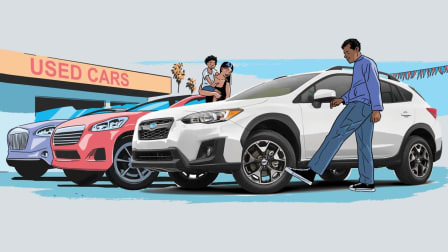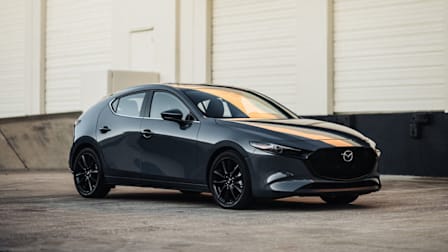The New 2023 Honda Accord Is Easy to Like and Easy to Live With
There’s nothing fussy or complex about it, although it might be hard to get the exact options you want

Update: Since this first drive was originally published in March, 2023, we finished testing the Honda Accord. Read the complete Honda Accord road test.
The redesigned 2023 Honda Accord is a traditional midsized family sedan with easy-to-use controls and a roomy interior. It also benefits from all the latest advanced safety features and a history of rock-solid reliability.
The Accord Hybrid is no longer a distinct model or trim level. Instead, the bottom two trims—LX and EX—come with a 1.5-liter four-cylinder turbo engine as the sole choice, while the top trims are only available with a hybrid powertrain. That’s an unusual choice, as most manufacturers who offer hybrids let owners pair them with lower trim levels, too. (Honda dropped the optional turbocharged 2.0-liter engine for 2023.) Regardless of which engine you choose, the Accord offers plenty of power—and a little excitement, too. Unlike the Nissan Altima, Subaru Legacy, and Toyota Camry, the front-wheel-drive Accord doesn’t offer an all-wheel drive option.
CR's Take
The Accord has a reputation as one of the most fun-to-drive, well-appointed mainstream family sedans. Honda’s latest redesign kept most of that charm.
While the updated Accord boasts a sleek appearance and pleasant driving experience, it falls short in terms of interior refinement. In addition, it can be hard to choose a trim level that has all the features you want and none that you don’t.
Despite these drawbacks, the new Accord does have one notable advantage: practicality. Drivers seeking clear visibility, user-friendly controls, and functional design will find that the Accord fits the bill. We’ll have to see whether the Hybrid’s fuel economy lives up to its promise when we conduct our own fuel-economy testing.
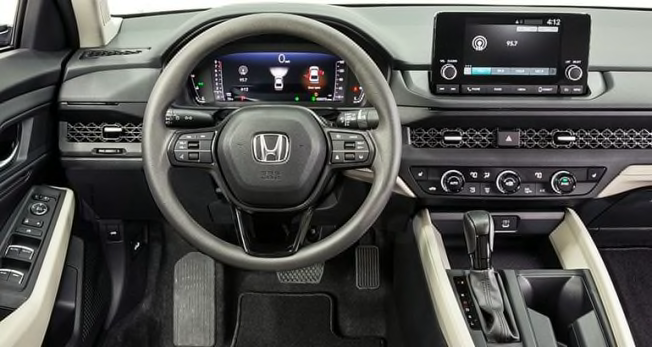
Photo: John Powers/Consumer Reports Photo: John Powers/Consumer Reports
What We Like
Controls: Step into the Accord and you might feel like you’ve gone back in time to an era when car interiors were immediately intuitive. Every frequently used feature has its own clearly labeled button or knob, and there’s even a traditional gear selector. The climate control knobs turn with a satisfying “click,” like a rotating bezel on a high-end watch. The entry-level cars get touchscreens surrounded with physical buttons, while the Hybrid Sport’s larger screen has an ever-present set of virtual buttons which make it easy to switch back and forth between AM/FM radio and Android Auto or Apple CarPlay. As one of our testers said, “It will take about 30 seconds for new owners to totally acclimate themselves to the car.” It’s a stark contrast to the steep learning curve we often encounter in many of the new vehicles we test.
Visibility and driving position: Good visibility isn’t always a given these days, so the view from the Accord is a pleasant surprise. The Accord’s roof pillars are unobtrusive, and it’s easy to check blind spots. Even with its coupelike roofline the rear side windows are large and useful. The driving position also offers a good view of the instrument cluster behind the steering wheel and a full view of the hood, too.
Powertrain(s): We like—but don’t love—both the hybrid and non-hybrid setups. There’s plenty of power on tap, and both the non-hybrid’s continuously variable transmission (CVT) and the hybrid’s two-motor setup do a good job keeping the engine from revving too high during everyday driving, which is an issue in many CVT-equipped and hybrid vehicles. But if you need a lot of power right away—merging uphill off a very short on-ramp, say—both engines get very loud, as they scramble to generate power. A handy dashboard indicator makes it easy to keep the Hybrid Sport in electric-only mode to save fuel.
Driving satisfaction: Traditionally, the Accord has been a bit sportier than other family sedans. The new model certainly isn’t going to be mistaken for a sports sedan in the vein of a BMW 3 Series, but we appreciated that it feels light on its feet. The steering is well-weighted and provides some feedback to the driver, and the ride is just firm enough to be composed yet comfortable. However, the Sport’s 19-inch wheels make for a slightly harsher ride compared with the 17-inch wheels on the EX model we tested.
Rear seats and cargo area: Rear passengers will enjoy ample room to stretch their legs, although taller folks may want more headroom. The cargo area is massive for a sedan, and a big trunk opening means that you can access almost all of it. And if that’s not enough, the rear seat folds down in sections. Just watch out for the exposed hardware inside the top of the cargo area, as it might scratch delicate items.
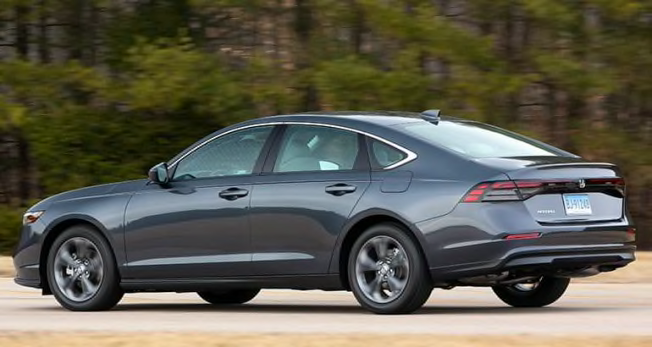
Photo: John Powers/Consumer Reports Photo: John Powers/Consumer Reports
What We Don't Like
Honda’s options strategy: Rather than offering features and extras as à la carte options, Honda always groups them into trim levels. For example, the Accord Hybrid Sport comes with a larger infotainment screen than the Accord EX, but it lacks the heated seats that are standard in the cheaper EX. The only way to get heated seats and a hybrid powertrain is to step up to the EX-L Hybrid, which costs $1,645 more and also adds leather.
Likewise, the Hybrid Sport has 19-inch wheels, while the EX has 17-inch wheels. Larger wheels tend to compromise ride comfort and also make for pricier tire replacements, but there’s no way to order smaller wheels on higher trims of the Accord. If you’re picky about particular options, there’s a chance you’ll end up paying for features you don’t want or need—kind of like how cable companies bundle the 10 channels you want to watch with a hundred you don’t care about.
Front seat comfort: At least in the EX, there’s a shortage of lower cushion and lower back support. Many of our drivers complained of an ailment they called “numb-butt,” caused by driving long distances while poised on a flat seat cushion that lacks padding. It’s a big disappointment in an otherwise great car, and some say it’s a deal breaker. We haven’t tested higher trim levels with leather seats, so we don’t know if they offer more support.
Inconsistent fit and finish: Compared with the satisfying controls, the EX’s plain plastic steering wheel is a letdown—even a fake leather covering would feel more pleasant and offer better grip. Other signs of obvious cost-cutting include a flat-black center console with hard plastic sides, door panels that lack any trim or stitching, and only one seatback storage pocket.
Noise: More road and wind noise comes through than in other vehicles in its class—especially in the back seat. The Hybrid sometimes turns the gas engine on just to charge the battery with the engine noise having no relation to acceleration. It kind of sounds like someone is mowing their lawn next door. If you floor the accelerator on either version—say, to merge real quick on a short on-ramp—the gas engine revs loudly and unpleasantly.
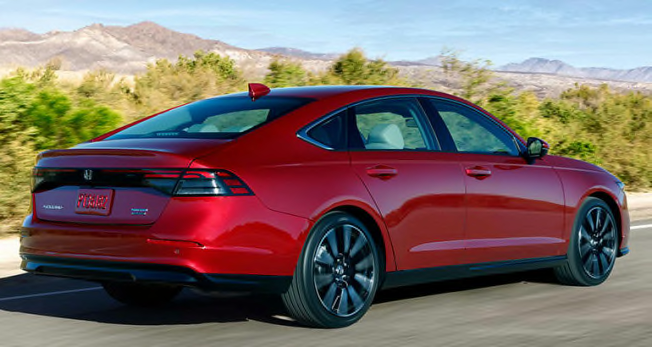
Photo: Honda Photo: Honda
What We'll Keep an Eye On
Advanced Driver Assistance Systems (ADAS): We’re glad that every Accord comes standard with the Honda Sensing suite of ADAS features, including forward collision warning (FCW), automatic emergency braking (AEB), automatic high-beam headlights, adaptive cruise control (ACC), and lane centering assistance (LCA). However, FCW seemed to be a bit overzealous, and LCA made the car feel like it was “ping-ponging” between lane lines. We’ll have a better sense of how it performs when we test it on CR’s new 1.5-mile ADAS loop, which we use to test these features. This new expansion to our Auto Test Center has challenging elements such as curves, split lanes, merging lanes, exit ramps, and intersections.


















